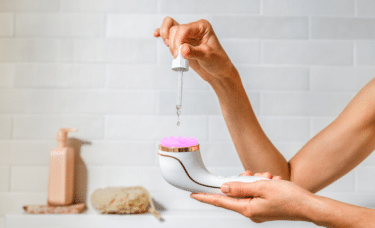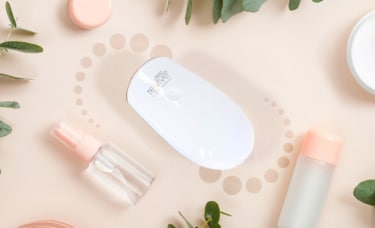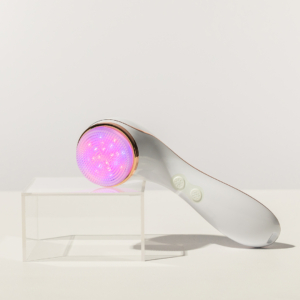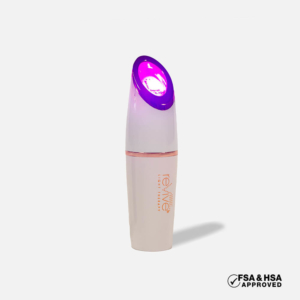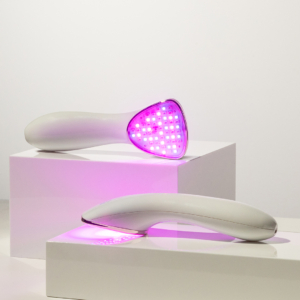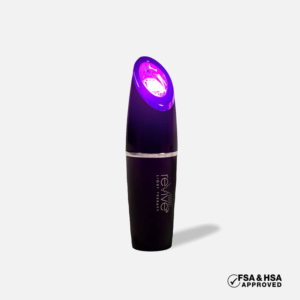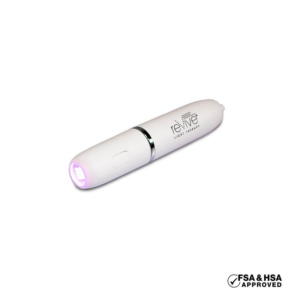Can You Use Vitamin C Serum with Red Light Therapy?
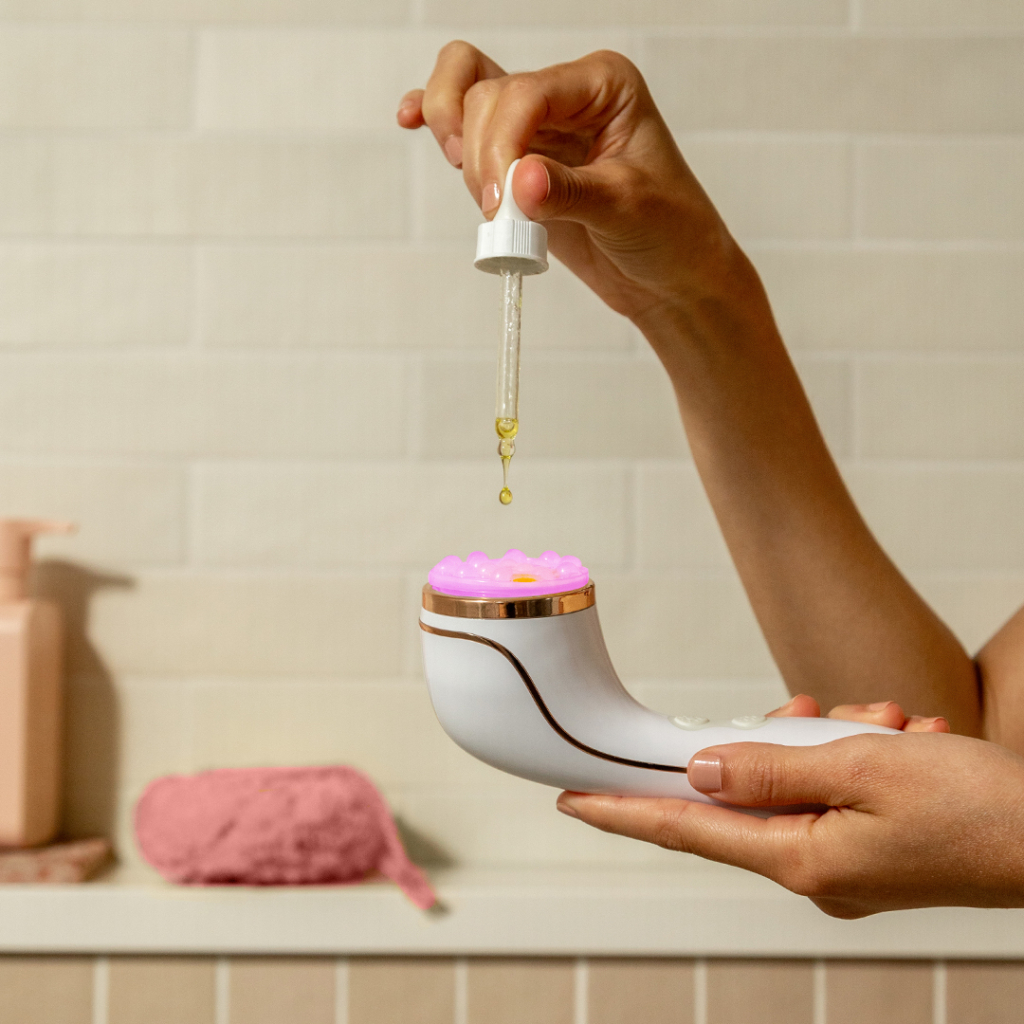
Visit any beauty blogger’s website and you’ll likely see recommendations for Vitamin C serums and moisturizers. Vitamin C helps boost the skin’s overall radiance and create an even skin tone. The question is, does it actually help? And is it safe to use Vitamin C products alongside other treatments like red light therapy? Here, we explore the benefits that Vitamin C offers your skin and how to make the most of the Vitamin C products you’ve been curious to try.
Table of Contents
What Are the Skincare Benefits of Vitamin C?
With consistent use, Vitamin C in beauty products can help tackle a variety of skincare concerns, including wrinkles, skin tone, and overall complexion — much like the results you would see from red light and blue light therapy.
Stimulates Collagen
Vitamin C has been proven to promote the natural production of collagen. When applied topically, Vitamin C provides hydrogen and oxygen to collagen cells, increasing their production. Collagen is what keeps skin from sagging and gives it an overall youthful look. Since our bodies naturally produce less collagen as we age, products that increase collagen production can support the reduction of wrinkles and fine lines.
Provides Skin-Brightening Antioxidants
Correcting dark spots or hyperpigmentation from acne or sun damage is a common cosmetic goal that consumers strive to achieve, and Vitamin C has shown positive results in addressing these concerns. Rich in antioxidants, Vitamin C prevents melanin production and targets the areas of uneven skin tone without over-brightening the rest of your skin.
Additionally, Vitamin C helps create a more even complexion if you struggle with inflammation and redness. If hyperpigmentation and inflammation aren’t of concern, the antioxidants in Vitamin C can still help smooth the skin’s surface and promote an overall bright, youthful glow.
Hydrates Skin
We all know how important it is to properly hydrate our bodies. As the body’s largest organ, skin is no exception to that. Derivatives are sometimes added to skincare products to preserve the benefits of all-star ingredients. When it comes to Vitamin C products, Magnesium ascorbyl phosphate is the most common derivative used. Alongside Vitamin C, this creates a hydrating effect on the skin.
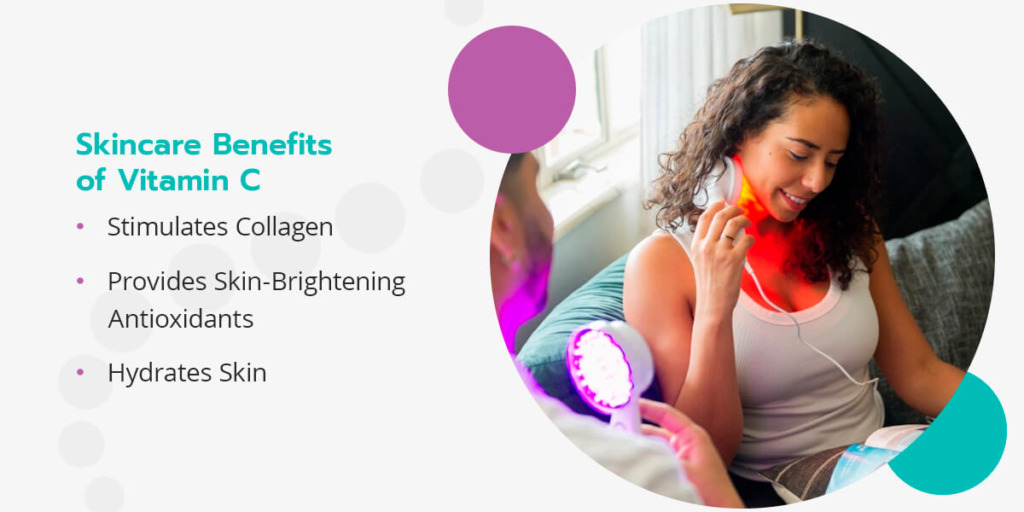
How to Choose the Right Vitamin C Skincare Product
Before purchasing a Vitamin C skincare product, you’ll want to conduct thorough research to ensure it’s safe, effective, and reliable. Here are three things you can do to ensure the product is trustworthy and that you’re getting your money’s worth:
1. Narrow Down on Product Type
If you want to get the best value, you’re likely better off choosing a Vitamin C serum instead of a Vitamin C cream or moisturizer. Skin absorbs serums more quickly, using higher concentrations of active ingredients. On the other hand, moisturizers and creams include other ingredients that thicken the product’s texture — therefore, they do not penetrate the skin as quickly.
2. Check the Potency
A quick online search for Vitamin C serums will render an overwhelming amount of results. It’s important to remember that not all Vitamin C products are the same, and potency is a top factor to consider before making a purchase. Higher potency means optimal absorption, resulting in a better-performing product. A key ingredient to look out for is L-ascorbic acid — this contains up to 20% of Vitamin C and will be the best bang for your buck.
3. Look for Proper Packaging
Exposure to air, light, and heat can degrade the ingredients in your Vitamin C serum. To ensure that your serum is high-quality with a longer shelf life, look for products that come packaged in a dark glass bottle. A serum with a dropper application rather than a pump is another key packaging feature to look out for, as it helps keep air out of the bottle.
With these three steps, thorough product comparison, and research, you can determine the best serum to use with LED light therapy.
Frequently Asked Questions About Vitamin C and LED Light Therapy
In these next few sections, we’ll answer some commonly asked questions you may have regarding the use of Vitamin C and red light therapy.
How Do the Benefits of Red Light Therapy Complement Vitamin C Serums?
Like Vitamin C serums, red light therapy is a non-invasive, therapeutic treatment that has been shown through scientific studies to be an effective anti-aging solution. Some red light therapy devices are developed with the same technology used by dermatologists, physicians, and influencers to help reduce and prevent signs of aging. Benefits of red light therapy that complement Vitamin C serums include:
Improved Complexion
Red light therapy has been shown to improve a person’s overall complexion. When put to the test by scientists in a controlled study of 136 volunteers, the results showed that the subjects’ skin complexion improved significantly.
Cellular Regeneration
At a cellular level, LED light therapy improves circulation and blood flow, which supports healing and cell regeneration. This has many positive effects on the skin, including stimulation of healing from sunburn or acne scarring, reduction of inflammation, and overall skin rejuvenation.
Wrinkle Reduction
Red Light Therapy encourages the production of collagen and elastin. Because collagen keeps the skin firmer and promotes a more youthful look, this boost in collagen production can help reduce fine lines and wrinkles.
Can You Use Vitamin C with Red Light Therapy?
If your primary skincare goal is to brighten your complexion with a boost of radiance, the brightening benefits of Vitamin C pair nicely with red light therapy. We could all use a little extra glow from time to time — this makes Vitamin C a versatile addition to nearly any skincare routine. On the other hand, if there are other skincare goals you want to prioritize, such as wrinkle reduction, you might explore how to use retinol with light therapy.
What Other Skincare Products Enhance Light Therapy Results?
Though light therapy can provide fast-acting results, you can certainly use other skincare products in conjunction with light therapy treatments. Many skincare professionals have found that combining light therapy with targeted skincare products, like those containing peptides, hyaluronic acid, green tea, and white tea, can help increase the effectiveness of the products up to 12 times.
Just remember that the order of application matters and that it’s best to apply serums after light therapy treatment.
What Should I Put on My Face Before Red Light Therapy?
For best results, it’s always recommended to use LED products on a clean face with no serums or moisturizers. This allows the light therapy to effectively penetrate the skin without any barriers.
Certain skincare products containing retinol or light-activated ingredients like sunscreen can be disruptive or harmful when applied directly before light therapy. While makeup typically doesn’t interfere with light therapy treatment, some foundations contain sunscreen that can block some of the light waves. For this reason, it’s best to use any LED tool on a bare, freshly-cleansed face.
After you’ve cleansed your skin, complete your light therapy session, then apply your Vitamin C serum of choice followed by a moisturizer. Remember to allow a few minutes in between each step of your routine, as serums typically need a couple of minutes to dry and to be fully absorbed by the skin.
Does Red Light Therapy Have Any Side Effects?
Generally speaking, there are virtually no side effects associated with red light therapy. If they do occur, it’s very rare. At most, you would experience some redness of the treated skin area, but this is very minor and temporary. You can take comfort in knowing that red light therapy is a painless, non-invasive process that is safe for all skin types.
How Long Before You See Results from Red Light Therapy?
Like any other form of therapeutic treatment, red light therapy won’t work overnight — it will typically require multiple sessions to start seeing results. It may take up to a few months to achieve full results from red light therapy so the process requires commitment and patience.
The good news is that with consistent sessions, you can achieve these results quicker. If you undergo red light therapy treatment on a regular basis, you’ll likely start to see faster results. Most professionals recommend receiving 2-3 treatments each week.
Find the Best Anti-Aging Red Light Therapy Device for You
From portable spot treatment devices to large handheld panels, reVive Light Therapy™ offers a wide selection of red light therapy tools to help you achieve your skincare goals. No matter what your current skincare routine looks like, red light therapy can take it up a notch and increase the overall radiance of your skin. Shop our full selection of anti-aging red light therapy devices.
Frequently Asked Questions
What wavelengths are used in light therapy?
- Health and wellness light therapy devices use LEDs that emit light in the blue, amber, red, or infrared range of the light spectrum, depending on the purpose. Energy wavelengths are shorter toward the blue end of the spectrum and longer toward the infrared end of the spectrum. The human eye can see light from about 380 nm (at the blue end) to about 750 nm (at the red end). The infrared waves can penetrate deeply to relieve muscle and joint pain, for example, while blue light works closer to the skin’s surface.
What are the benefits of red light therapy?
- Anti-aging & Healing: Red light therapy is an anti-aging treatment that reduces wrinkles and other signs of aging. It can also reduce inflammation and support tissue regeneration.
- Safety: Red light therapy is a safe, natural treatment for various skin conditions.
- At-home devices: With at-home light therapy devices, red light therapy is easy and convenient, making it simple to implement in a skincare routine.
- Non-invasive: Red light therapy is a relatively low-risk treatment with widespread health benefits and is easy to use.
Does red light therapy use UV wavelengths?
- Red and infrared LEDs produce no UV rays, so there’s no risk of skin cancer like there is from the sun. LED light therapy uses LEDs that emit non-invasive, non-UV wavelengths to promote cellular growth and relieve a range of conditions.
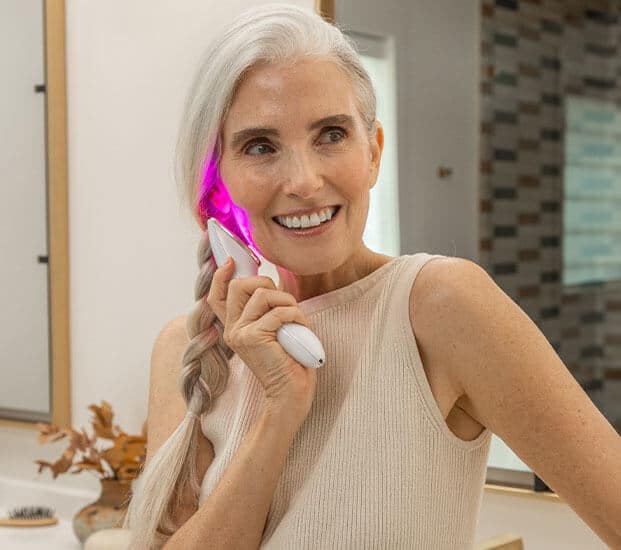
Experience the power of light therapy at home
Specific wavelengths of light have different effects, and can be used for a variety of applications — from destroying acne-causing bacteria to killing harmful germs on your phone. Our light therapy devices allow you to harness the power of LEDs in the comfort of your own home.
See How It Works


